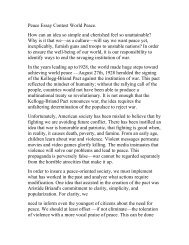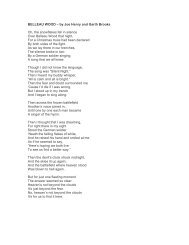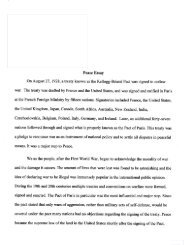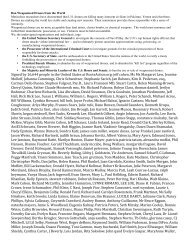y the patrimonial nature <strong>of</strong> Saddam’s system have now, with the disappearance <strong>of</strong> the highrank<strong>in</strong>gmembers, risen to control the <strong>in</strong>surgency.” He added that after the American attack andseveral weeks “<strong>of</strong> be<strong>in</strong>g like deer <strong>in</strong> headlights,” these Baathists had become <strong>org</strong>anized, and weredirect<strong>in</strong>g and lead<strong>in</strong>g operations aga<strong>in</strong>st Americans. Dur<strong>in</strong>g an <strong>in</strong>terview <strong>in</strong> Wash<strong>in</strong>gton, a seniorArab diplomat noted, “We do not believe that the resistance is loyal to Saddam. Yes, theBaathists have re<strong>org</strong>anized, not for political reasons but because <strong>of</strong> the terrible decisions madeby Jerry Bremer”—the director <strong>of</strong> the C.P.A. “The <strong>Iraq</strong>is really want to make you pay the price,”the diplomat said. “Kill<strong>in</strong>g Saddam will not end it.”Similarly, a Middle Eastern bus<strong>in</strong>essman who has advised senior Bush Adm<strong>in</strong>istration <strong>of</strong>ficialstold me that the re<strong>org</strong>anized Baath Party is “extremely active, work<strong>in</strong>g underground withpermanent <strong>in</strong>ternal communications. And without Saddam.” Baath party leaders, he added,expect Saddam to issue a public statement <strong>of</strong> self-criticism, “tell<strong>in</strong>g <strong>of</strong> his mistakes and hisexcesses,” <strong>in</strong>clud<strong>in</strong>g his reliance on his sons.There is disagreement, <strong>in</strong>evitably, on the extent <strong>of</strong> Baathist control. The former <strong>Is</strong>raeli military<strong>in</strong>telligence<strong>of</strong>ficer said, “Most <strong>of</strong> the firepower comes from the Baathists, and they know wherethe weapons are kept. But many <strong>of</strong> the shooters are ethnic and tribal. <strong>Iraq</strong> is very factionalizednow, and with<strong>in</strong> the Sunni community factionalism goes deep.” He added, “Unless you settlethis, any effort at reconstruction <strong>in</strong> the center is hopeless.”The American military analyst agreed that the current emphasis on Baathist control “overlooksthe nationalist and tribal angle.” For example, he said, the anti-coalition forces <strong>in</strong> Falluja, a majorcenter <strong>of</strong> opposition, are “driven primarily by the sheikhs and mosques, <strong>Is</strong>lam, clerics, andnationalism.” The region, he went on, conta<strong>in</strong>s “tens <strong>of</strong> thousands <strong>of</strong> unemployed former military<strong>of</strong>ficers and enlistees who hang around the c<strong>of</strong>fee shops and restaurants <strong>of</strong> their relatives; theyplot, plan, and give and receive <strong>in</strong>structions; at night they go out on their missions.”This military analyst, like many <strong>of</strong>ficials I spoke to, also raised questions about the military’smore conventional tactics—the aggressive program, code-named Iron Hammer, <strong>of</strong> bomb<strong>in</strong>gs,nighttime raids, and mass arrests aimed at trouble spots <strong>in</strong> Sunni-dom<strong>in</strong>ated central <strong>Iraq</strong>. The<strong>in</strong>surgents, he told me, had already developed a response. “Their S.O.P.”—standard operat<strong>in</strong>gprocedure—“now is to go further out, or even to other towns, so that American retribution doesnot fall on their locale. Instead, the Americans take it out on the city where the <strong>in</strong>cidenthappened, and <strong>in</strong> the process they succeed <strong>in</strong> mak<strong>in</strong>g more enemies.”The brazen <strong>Iraq</strong>i attacks on two separate American convoys <strong>in</strong> Samarra, on November 30th,provided further evidence <strong>of</strong> the diversity <strong>of</strong> the opposition to the occupation. Samarra has beena center <strong>of</strong> <strong>in</strong>tense anti-Saddam feel<strong>in</strong>gs, accord<strong>in</strong>g to Ahmed S. Hashim, an expert on terrorismwho is a pr<strong>of</strong>essor <strong>of</strong> strategic studies at the U.S. Naval <strong>War</strong> College. In an essay published <strong>in</strong>August by the Middle East Institute, Hashim wrote, “Many Samarra natives—who had servedwith dist<strong>in</strong>ction <strong>in</strong> the Baath Party and the armed forces—were purged or executed dur<strong>in</strong>g thecourse <strong>of</strong> the three decades <strong>of</strong> rule by Saddam and his cronies from the rival town <strong>of</strong> Tikrit.” Hewent on, “The type <strong>of</strong> U.S. force structure <strong>in</strong> <strong>Iraq</strong>—heavy armored and mechanized units—andthe psychological disposition <strong>of</strong> these forces which have been <strong>in</strong> <strong>Iraq</strong> for months is simply notconducive to the successful wag<strong>in</strong>g <strong>of</strong> counter-<strong>in</strong>surgency warfare.”48
The majority <strong>of</strong> the Bush Adm<strong>in</strong>istration’s manhunt<strong>in</strong>g missions rema<strong>in</strong> classified, but oneearlier mission, <strong>in</strong> Afghanistan, had mixed results at best. Last November, an Al Qaeda leadernamed Qaed Salim S<strong>in</strong>an al-Harethi was killed when an unmanned Predator reconnaissanceaircraft fired a Hellfire missile at his automobile <strong>in</strong> Yemen. Five passengers <strong>in</strong> the automobilewere also killed, and it was subsequently reported that two previous Predator missions <strong>in</strong> Yemenhad been called <strong>of</strong>f at the last moment when it was learned that the occupants <strong>of</strong> suspect vehicleswere local Bedou<strong>in</strong>s, and not Al Qaeda members.S<strong>in</strong>ce then, an adviser to the Special Forces command has told me, <strong>in</strong>fight<strong>in</strong>g among the varioussenior military commands has made it difficult for Special Forces teams on alert to takeimmediate advantage <strong>of</strong> time-sensitive <strong>in</strong>telligence. Rumsfeld repeatedly criticized Air ForceGeneral Charles Holland, a four-star Special Forces commander who has just retired, for hisreluctance to authorize commando raids without specific, or “actionable,” <strong>in</strong>telligence. Rumsfeldhas also made a systematic effort to appo<strong>in</strong>t Special Forces advocates to the top military jobs.Another former Special Forces commander, Army General Peter Schoomaker, was brought out<strong>of</strong> retirement <strong>in</strong> July and named Army Chief <strong>of</strong> Staff. The new civilian Assistant Secretary forSpecial Operations <strong>in</strong> the Pentagon is Thomas O’Connell, an Army veteran who served <strong>in</strong> thePhoenix program <strong>in</strong> Vietnam, and who, <strong>in</strong> the early eighties, ran Grey Fox, the Army’s secretcommando unit.Early <strong>in</strong> November, the Times reported the existence <strong>of</strong> Task Force 121, and said that it wasauthorized to take action throughout the region, if necessary, <strong>in</strong> pursuit <strong>of</strong> Saddam Husse<strong>in</strong>,Osama b<strong>in</strong> Laden, and other terrorists. (The task force is commanded by Air Force BrigadierGeneral Lyle Koenig, an experienced Special Forces helicopter pilot.) At that po<strong>in</strong>t, the formerSpecial Forces <strong>of</strong>ficial told me, the troops were “chas<strong>in</strong>g the deck <strong>of</strong> cards. Their job was to f<strong>in</strong>dSaddam, period.” Other Special Forces, <strong>in</strong> Afghanistan, were target<strong>in</strong>g what is known as theA.Q.S.L., the Al Qaeda Senior Leadership List.The task force’s search for Saddam was, from the beg<strong>in</strong>n<strong>in</strong>g, daunt<strong>in</strong>g. Accord<strong>in</strong>g to Scott Ritter,a former United Nations weapons <strong>in</strong>spector, it may have been fatally flawed as well. From 1994to 1998, Ritter directed a special U.N. unit that eavesdropped on many <strong>of</strong> Saddam Husse<strong>in</strong>’sprivate telephone communications. “The high-pr<strong>of</strong>ile guys around Saddam were the murafaq<strong>in</strong>,his most loyal companions, who could stand next to him carry<strong>in</strong>g a gun,” Ritter told me. “Butnow he’s gone to a different tier—the tribes. He has released the men from his most sensitiveunits and let them go back to their tribes, and we don’t know where they are. The manifests <strong>of</strong>those units are gone; they’ve all been destroyed.” Ritter added, “Guys like Farouq Hijazi candeliver some <strong>of</strong> the Baath Party cells, and he knows where some <strong>of</strong> the <strong>in</strong>telligence people are.But he can’t get us <strong>in</strong>to the tribal hierarchy.” The task force, <strong>in</strong> any event, has shifted its focusfrom the hunt for Saddam as it is <strong>in</strong>creas<strong>in</strong>gly distracted by the spread<strong>in</strong>g guerrilla war.In addition to the Special Forces <strong>in</strong>itiative, the military is also explor<strong>in</strong>g other approaches tosuppress<strong>in</strong>g the <strong>in</strong>surgency. The Wash<strong>in</strong>gton Post reported last week that the Americanauthorities <strong>in</strong> Baghdad had agreed, with some reluctance, to the formation <strong>of</strong> an <strong>Iraq</strong>i-ledcounter-terrorism militia composed <strong>of</strong> troops from the nation’s five largest political parties. Theparamilitary unit, totall<strong>in</strong>g some eight hundred troops or so, would “identify and pursue49
- Page 7 and 8: guard was called upon. Now people l
- Page 11 and 12: After the commandos set up their he
- Page 13 and 14: more skilled than American troops I
- Page 15 and 16: ‘‘I think it was all an act to
- Page 17 and 18: Ministry of Interior Security Force
- Page 19 and 20: ‘‘For some, there’s definitel
- Page 21 and 22: with prominent Shiite cleric Hussei
- Page 23 and 24: The Police Commandos’ penchant fo
- Page 25 and 26: effective at responding to the atta
- Page 27 and 28: http://zmagsite.zmag.org/Nov2005/da
- Page 29 and 30: In another twist, the bodies of 8 m
- Page 31 and 32: Subject: [oneheartpeacework] Traine
- Page 33 and 34: 3. Maass, Peter, "The Way of the Co
- Page 35 and 36: We now have Judith Miller’s New Y
- Page 37 and 38: arrangements with the CEO of the Ir
- Page 39 and 40: November 6, 2003, was designated fo
- Page 41 and 42: March 9, 2006 -- Los Angeles Times
- Page 43 and 44: http://www.newyorker.com/printables
- Page 45 and 46: The former official says that the B
- Page 47: officials in Colombia. The book “
- Page 51 and 52: Part Three:200451
- Page 53 and 54: military base on Honduran territory
- Page 55 and 56: Not everyone in Chile is opposed to
- Page 57 and 58: Secret US Gulfstream jets and Swedi
- Page 59 and 60: If ever possible…FOOTNOTES:Seymou
- Page 61 and 62: Part Four:200561
- Page 63 and 64: The organization said U.S. and Iraq
- Page 65 and 66: For starters, what’s been written
- Page 67 and 68: http://www.counterpunch.org/hersh01
- Page 69 and 70: Fallujah I called him at home. I'm
- Page 71 and 72: these people worked as night clerks
- Page 73 and 74: http://nyc.indymedia.org/newswire/d
- Page 75 and 76: y shifting their targets, concentra
- Page 77 and 78: * Arun Gupta, former editor of The
- Page 79 and 80: From Iran-Contra To IraqThe NationB
- Page 81 and 82: his actions this time around become
- Page 83 and 84: might have been imagined.According
- Page 85 and 86: put out by the Interior Ministry, t
- Page 87 and 88: in/article.cgi?file=/chronicle/arch
- Page 89 and 90: However, the analogy is misleading
- Page 91 and 92: http://nytimes.com/cfr/internationa
- Page 93 and 94: which have raised sectarian tension
- Page 95 and 96: http://select.nytimes.com/gst/abstr
- Page 97 and 98: A grocer in west Baghdad told Salih
- Page 99 and 100:
use of their experience in mass rep
- Page 101 and 102:
Iran's Revolutionary Guards. Iraqi
- Page 103 and 104:
http://www.informationclearinghouse
- Page 105 and 106:
The slaughter and destruction in we
- Page 107 and 108:
SEC. RUMSFELD: I'm not going to com
- Page 109 and 110:
insurgency. The Iraqi forces, the m
- Page 111 and 112:
Part Five:2006111
- Page 113 and 114:
They told soldiers they were taking
- Page 115 and 116:
http://www.countercurrents.org/iraq
- Page 117 and 118:
One photo showed what appeared to b
- Page 119 and 120:
Maj. Gen. Hussein Kamal, who announ
- Page 121 and 122:
Baghdad, the 14 Sunnis seized from
- Page 123 and 124:
"You've got the facilities protecti
- Page 125 and 126:
Peterson, the U.S. officer in charg
- Page 127 and 128:
homes or mosques by men in uniform
- Page 129 and 130:
moniker that sounds about as unauth
- Page 131 and 132:
there is a general consensus that t
- Page 133 and 134:
the government officials, media lac
- Page 135 and 136:
experience with Saddam's government
- Page 137 and 138:
http://www.globalecho.org/view_arti
- Page 139 and 140:
working within the country's interi
- Page 141 and 142:
Mr. Karim was originally sentenced
- Page 143 and 144:
Close to one million Iraqis, most o
- Page 145 and 146:
Neither Republicans nor Democrats s
- Page 147 and 148:
Democratic position and that of the
- Page 149 and 150:
This year's Democratic primaries an
- Page 151 and 152:
http://www.informationclearinghouse
- Page 153 and 154:
Of Hariri's assassination, Syrian o
- Page 155 and 156:
Sourcewatch information on Aegis:
- Page 157 and 158:
RAMOPS RISK MANAGEMENT GROUP (compr
- Page 159 and 160:
Section 2: Organization of the FPS1
- Page 161 and 162:
The UK was criticized for starting
- Page 163 and 164:
http://www.washingtoninstitute.org/
- Page 165 and 166:
FPS, proposing to give its members
- Page 167 and 168:
http://www.greenleft.org.au/2006/68
- Page 169 and 170:
personnel and CIA operators and con
- Page 171 and 172:
Although Bush hasn't specifically s
- Page 173 and 174:
massive military aid to the Salvado
- Page 175 and 176:
The convoy was traveling in the Cam
- Page 177 and 178:
http://www.timesonline.co.uk/articl
- Page 179 and 180:
http://news.independent.co.uk/world
- Page 181 and 182:
The Mehdi Army does not always have
- Page 183 and 184:
clarification of what happened in S
- Page 185 and 186:
http://www.brusselstribunal.org/Bri
- Page 187 and 188:
"What our police found in their car
- Page 189 and 190:
3. the international cadre of war f
- Page 191 and 192:
If you thought the U.S. wouldn't bl
- Page 193 and 194:
Regrettably, that is prospect that
- Page 195 and 196:
The initial demand from the puppet
- Page 197 and 198:
www.prisonplanet.com/articles/septe
- Page 199 and 200:
FLASHBACK: Sick strategies for sens
- Page 201 and 202:
into the river. That thought alone
- Page 203 and 204:
Zarqawi is actually a real person o
- Page 205 and 206:
Examples “were found during the M
- Page 207 and 208:
Witnesses said about 150 Iraqi pris
- Page 209 and 210:
A British military source has said
- Page 211 and 212:
Meanwhile, frantic negotiations con
- Page 213 and 214:
The British troops believed the two
- Page 215 and 216:
Naturally, the sleazy Laurence-emul
- Page 217 and 218:
eing arrested by the Iraqi police o
- Page 219 and 220:
When viewed in the context of all t
- Page 221 and 222:
throw rose petals at the invaders,
- Page 223 and 224:
enders’ in the Sunni Community. S
- Page 225 and 226:
thus making people believe that cas








